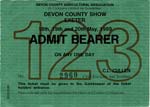
The Devon County Show
Page added 23rd July 2011
By Dick Passmore
The first show was a two-day event, held at Victoria Park, Mount Radford, Exeter. In what has almost become true County Show tradition, the first day experienced heavy rain, and the President’s marquee, (where luncheon was being held for some 400 guests) was a washout! The admission price was 6d. per person, and the show included the Band and Pipers of the 42nd Royal Highlanders, who were engaged for £40! The 300 posters printed to advertise the show cost £9, and the catalogues cost £40 to print! Some 25,000 people attended over the two days, and the show was able to show a profit in excess of £500. Slightly different from today’s figures, as will be seen.
The 1872 show was mainly a showcase for local breeds – some 500 animals being exhibited including Devon Reds, South Devons, Shorthorns, and Channel Island breeds, plus sheep from Exmoor, Dartmoor & South Devon. Machinery, which is said to have had 800 exhibits, although that is surely questionable, included two-horse reapers, chaff-cutters, three-row turnip, manure and seed drills, winnowing machines, double-furrow ploughs and horse rakes. Farmers came to the show not by motorised transport, but by horse, or horse and trap, and the more wealthy “gentlemen farmers” and their wives arrived in landaus, broughams, phaetoms and similar carriages. These would have been either privately owned, or hired for the occasion from carriage companies.
All over the county
The annual Devon County Show originally went from place to place, rather than having any permanent home. Some of the places hosting the show were Plymouth, Barnstaple, Newton Abbot, Tiverton, Tavistock, Honiton, Crediton, Bideford and Torquay. In 1875, W.J. Winter took over as Show secretary, and the Show (at Torrington) received its first Royal visitor – The Duke of Cambridge. In 1899 the show was held in Exeter, in conjunction with The Royal Bath & West. The 1914 show – the last to be staged until after the Great War – was held at Totnes. The first post-War show was at Exeter in 1920, when the city’s M.P., Sir Robert Newman, was President. The following year, was at Tavistock, when The Prince of Wales, as President, paid a visit to the Show. In 1926 the show was put back to mid-June, owing to the General Strike, and in 1932 the Show moved back to Tavistock and received the second Royal President, The Duke of Kent.
War halts the show
1939 saw the Show taking place at Axminster, where it cost £3,250 to stage, but then War once again intervened, with no shows until 1947, when it once more visited Exeter. The Show Secretary, Percy Whitton, had died during the War years, and was temporarily succeeded by his son, Geoffrey, until Leslie Stagg was appointed in 1947. It was around this time that negotiations were in hand to create a permanent show site at Winslade, Clyst St Mary, near Exeter, but these negotiations were never completed, and the show carried on “travelling”.
The Show welcomed The Duchess of Gloucester at Barnstaple in 1950, and in 1955 the Devon County Show saw a major change when it returned to Exeter. Leslie Stagg retired as secretary, and his place was taken by C.F.J. Hocken. John Hocken and his committee started talks with Exeter City Council to establish a permanent site at Whipton, and this was achieved in time for John’s first show in 1956. Princess Alexandra visited that Show and saw The King’s Troop, Royal Horse Artillery, take part. There were record crowds in 1957 when The Royal Canadian Mounted Police display was the main attraction.
In 1963 a large, two-tiered trade stand collapsed, fortunately without causing any injuries. In 1964 new cattle buildings were opened at Whipton, at a cost of £40,000. They were able to house 400 cattle and had temporary accommodation for 80 herdsmen. That year saw very bad weather, but a large attendance. Three years later The Duchess of Kent was welcomed by the President, A.S. Newbery Esq. In 1969 the Show President was Colonel H.C. Kingsford Lethbridge, whose family had connections in Canada – the city of Lethbridge having been named after one of his ancestors. That year (quite naturally) saw a welcome return of the “Mounties”, and the Canadian High Commissioner also attended.
Centenary Year
1972 was, of course, the centenary year of the Devon County Agricultural Association, with Lord Roborough as President. The Royal guest was The Duchess of Gloucester, and the show jumping events attracted such names as Harvey Smith, Caroline Bradley, Marion Mould and Ted Edgar, and the attendance that year exceeded 80,000. To mark the centenary, the President hosted a banquet for 700 guests in, believe it or not, the cattle buildings!
Three years later, in 1975, The Duke of Gloucester attended the Show, as did the ever-popular Earl Mountbatten of Burma, sadly to be assassinated by the IRA four years later. 1975 saw The Foire de Caen (The Caen Fair) exhibit for the first time, striking up a French connection with the two shows. This was also the year that a fire broke out at the entrance to the Show Feature “Our Farming Heritage”. Luckily there were no injuries, and little damage caused. In 1979 The Prince of Wales agreed to be the show President, and attended on the first day.
In 1981 John Hocken celebrated 25 years as Show secretary, and 1983 was one of the years the Ground Staff will remember well, as the weather before and during the show was atrocious. Hundreds of tons of stone were brought in to make roadways in the mud, and tractors were laid on to pull vehicles out of the car park fields that resembled ploughed fields. The Princess Anne visited in 1985, when the main ring attraction was the Musical Ride of the Household Cavalry.The final show at Whipton was in 1989 when the President was, for the first time, a lady – Lady Margaret Fortescue. The children of Chudleigh Primary School produced a special newspaper for the Show, and the final paragraph asked the last person to leave to ‘turn out the lights and return the key to Exeter City Council’!
The move to Westpoint
After thirty years at the Whipton site, in 1990 the Devon County Show moved to a new, much larger site at Clyst St Mary, an area that had been looked at more than forty years before. The new site, however, was not Winslade Park, but a few yards up the road at Ivington Farm. It was re-named Westpoint from the very start. The farm was purchased by the Association, and work started on converting it into not only a home for the County show, but a “venue in a truly national and international league” according to the glossy promotional brochure. It was estimated that the cost of the works would be in excess of £3 million, although the Association’s bank balance was not even a third of that at the time! The main arena at Westpoint was to provide the Exeter area with one of the largest clear-span buildings in Britain, giving over 50,000 square feet of unobstructed floor space, and a building capable of seating 6,000 people. It would, the brochure claimed, be ‘capable of being used for almost anything’. Some of the claims made by the promotional team were, of course, slightly wide of the mark in reality. For example, the original farmhouse and ancillary buildings were to become “high-class self-catering accommodation in the heart of the site”. It would boast “54 single or twin bed rooms on three floors, capable of accommodating over 100 people”, and the central barn was to be converted “to provide a lounge with TV and cooking facilities”. That has not been achieved, the main farmhouse being the D.C.A.A. offices, whilst half of the barns are still used for storage. There is no accommodation available. A further claim of a Pavilion alongside the main ring, with hospitality suites, bar and kitchen facilities, conference facilities, and balconies overlooking events in the ring, has also never come to fruition, for there is no grandstand, let alone any classy pavilion.
Nevertheless, Westpoint is proving very adaptable, and indeed successful. It is being used by a multitude of businesses and organisations for all manner of events, from craft exhibitions to musical events, from dog shows to wedding shows, and from Christmas fairs to Self-Build exhibitions. The Girl Guide Movement have an annual rally at Westpoint, as does a local Historic Transport organisation. With over 150 acres at the site’s disposal, there is ample room for large or small events, or even more than one event at the same time. The main arena doubles as an exhibition area and, for the County Show, a cattle shed. Tarmac roads have been created all over the site, making it very adaptable even in bad weather, and even traffic lights have been installed for use by the Devon Driver Training Centre. Large car parks can accommodate well over 12,000 cars at any one time, and the infrastructure ensures a reasonably smooth passage even on the heaviest day of the County Show.
It is, of course, during the Devon County Show that the site really comes into its own, with an average of around 30,000 visitors coming through the turnstiles for each of the three days a year. A vast number of exhibitors can be allocated spaces in all parts of the showground, and there is always a waiting list. The main ring is supplemented by the horse ring, although the major show-jumping events are kept for the main ring. There is room for a small fairground, and a secondary ring is available for various other displays, including the Military. Permanent water and electricity is available throughout the site, making the lives of exhibitors and other users that much easier, and of course public toilet facilities have improved greatly in recent years – but purpose built toilet blocks would be a great advantage.
From a relatively small beginning in 1872, the Devon County Show is now one of the accredited country shows, and can boast one of the best showgrounds in the country. Over the years, many notables and personalities have visited the Show – Government Ministers, High Commissioners of the Commonwealth and other countries, so-called “stars” of the television and radio world (purely as crowd pullers), and even one “Miss World”! Royal patronage has continued, and in 1994 Princess Margaret visited. More recently The Prince of Wales and Camilla Parker-Bowles attended, and their very presence alone increased the number of visitors that year. The continuing appetite the public has for the Show means that it has to have ‘crowd pulling’ power, and that, of course, means ever-spiralling costs. “Attractions” do not come cheaply these days. The very first show cost a few hundred pounds to stage, whilst the erection of the show-yard at Newton Abbot a few years later cost just under £4,000. The cost has inevitably risen year by year. When John Hocken became secretary in 1955, the show cost around £20,000 to put on, and by the 1970s it had risen to around £60,000. Today, of course, we are talking well into six figures even before the first visitor is admitted through the gate! It is not difficult to foresee the day when it will cost in excess of £1 million to put on the County Show. In 1872, some 25,000 people saw the show over two days – an exceedingly good number – but today the show caters for around that number on each of the three days!
In the first half of 20th century the Devon County Show was primarily concerned with farming and agriculture in general, but the second half of the century allowed for an increasing public awareness, and since the middle of that century the entertainment degree of the show has increased annually, with displays and attractions attracting large numbers through the turnstiles. Today the Devon County Show remains mainly related to agriculture, but also has to cater for a diversifying public interest, and it does so with style, in the true tradition of the “local agricultural show”.
Let the wealthy and great
roll in splendour and state,
I envy them not, I declare it.
I eat my own lamb,
my chickens and ham,
I shear my own sheep and I wear it.
I have lawns, I have bowers
I have fruits, I have flowers,
The lark is my morning alarmer.
So jolly boys now,
Here’s God speed the plough,
long life, and success to the farmer.
© Dick Passmore
Clcik on image with red border to enlarge.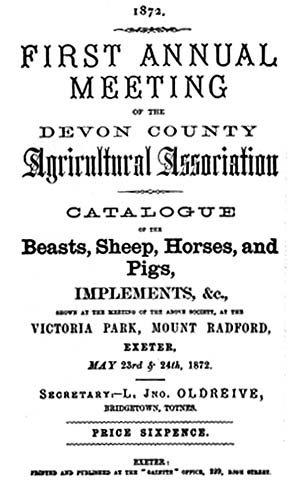 The poster for the First Devon County Show in 1872.
The poster for the First Devon County Show in 1872.
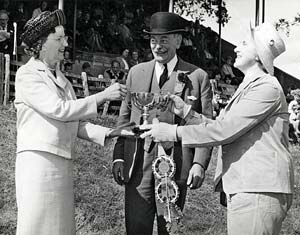 Col. Kingsford-Lethbridge (President) presenting a prize in 1969.The Whipton Showground in 19
Col. Kingsford-Lethbridge (President) presenting a prize in 1969.The Whipton Showground in 19
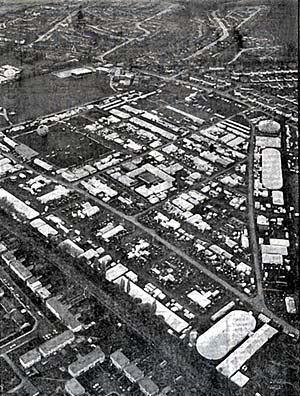 The Whipton Show Ground in 1988. Courtesy Western Morning News.
The Whipton Show Ground in 1988. Courtesy Western Morning News.
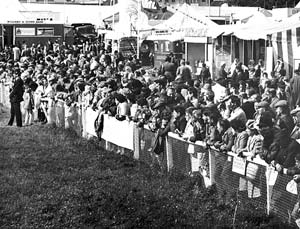 Part of the crowd at the 1971 Show.
Part of the crowd at the 1971 Show. 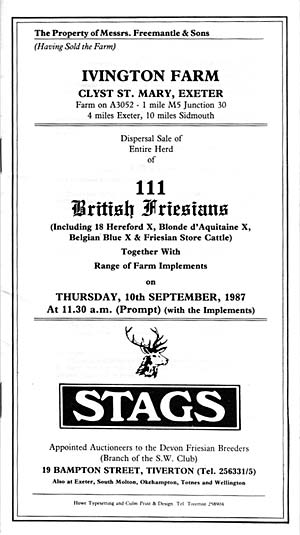 Programme for dispersal sale of Ivington Farm prior to it becoming the Westpoint Showground.
Programme for dispersal sale of Ivington Farm prior to it becoming the Westpoint Showground.
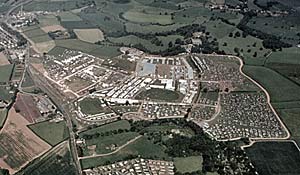 The first show at Westpoint in 1990. Courtesy of Devon and Cornwall Police.
The first show at Westpoint in 1990. Courtesy of Devon and Cornwall Police.
Unless stated otherwise, all images are from Dick Passmore's personal collection.
│ Top of Page │
